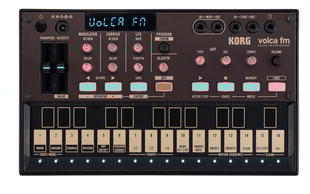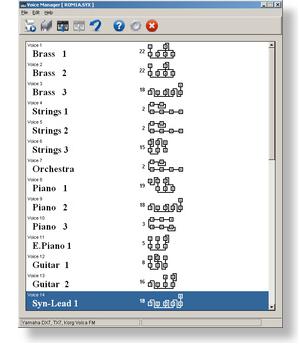Volca FM2 Synthesizer
![]()
![]()
![]()
![]()
![]()
![]()
![]()
![]()

The Yamaha DX7 was a brilliant keyboard synthesizer… albeit during the early 1980s. Rather than creating sounds by patching together filters and oscillators with short bits of wire, it simulated the acoustic effects of physical instruments through digital FM synthesis. While the theory behind FM synthesis requires a fairly impenetrable book to fully appreciate, it can play some inspiring music.
In some quarters, the DX7 was the sound of its decade.
One of the most sophisticated aspects of the DX7 was its capacity for having its voices programmed by its users. Banks of 32 voices could be downloaded from the instrument, stored on what were somewhat imaginatively called computers at that time, and thereafter uploaded back to a DX7. Thousands of voice banks were created for it.
While it was shockingly cool, the DX7 was not without its drawbacks. It was huge, heavy and beset with primitive digital to analog converters that infused everything it played with a vaguely electronic edge. Its nasty spring-loaded plastic keyboard was challenging.
We gave our last DX7 away years ago. We kind of regret this, as they’re currently selling for serious cash on Reverb.
The original Korg Volca FM was a DX7 with none of the foregoing issues. About the size of a paperback book, it offered a flawless emulation of the DX7’s FM sound engine, with full voice bank compatibility. It would accept any of the extant DX7 voice banks and play them through vastly superior twenty-first century technology. It also cost a fraction of what an original DX7 would have crushed someone’s plastic for back in the day.
The Volca FM was beset with a few demons of its own, most notably its lack of polyphony. A DX7 is capable of playing sixteen notes simultaneously. A first-generation Volca FM could manage three. It was nice for lead lines, but it didn’t entail much complexity to see it run out of notes.
It also lacked support for sustain and keyboard velocity.
The X
The Volca FM2, as its name should imply, is the second-generation of Korg’s DX7 emulators, and to a large extent it addresses the shortcomings of its ancestor. It embodies six-note polyphony, which isn’t the equal of an original DX7, but it’s arguably sufficient unless you habitually play with your elbows. It has sustain and velocity sensitivity… albeit with a slight catch, which we’ll get to in a moment. It also has a more elaborate effects section, which can be enabled if you’d like to impose a contemporary vibe upon its FM synthesis engine.
Please note that we’re in no way responsible for any emotional trauma or physical injury inflicted upon serious FM enthusiasts who read the foregoing sentence. While it’s an interesting addition to the Volca FM synthesizer, we found that we were happier with the reverb and chorus turned down or switched out entirely.
 The Volca FM2 has its quirkiness dialed up to 11, as did its predecessor. It has a fully editable FM synthesis engine, which can be programmed through its diminutive user interface. Its controls even reproduce the circa-1983 color palette of a genuine DX7. However, where the DX7’s user interface was somewhat inscrutable, that of the Volca FM2 is largely impenetrable. If you want to program your own voices, you’ll almost certainly want to use software running on another device. Perhaps not surprisingly, we recommend our Voice Manager application.
The Volca FM2 has its quirkiness dialed up to 11, as did its predecessor. It has a fully editable FM synthesis engine, which can be programmed through its diminutive user interface. Its controls even reproduce the circa-1983 color palette of a genuine DX7. However, where the DX7’s user interface was somewhat inscrutable, that of the Volca FM2 is largely impenetrable. If you want to program your own voices, you’ll almost certainly want to use software running on another device. Perhaps not surprisingly, we recommend our Voice Manager application.
In defense of the Volca FM2, creating a more workable programming interface in the space this device occupies would have required extended thought-control technology, which would have certainly increased its price substantially.
The display panel of the Volca FM2 maintains the curious affectation of the original Volca FM – rather than an alpha-numeric LCD screen, it uses twentieth-century seven-segment light-emitting diode displays. It simulates a more or less readable alphabet with them, but you’ll probably find that deciphering it entails a brief learning curve.
The primary visual distinction between the Volca FM2 and the original Volca FM is its display, which is blue rather than red.
The Volca FM2’s user interface includes a tiny touch-sensitive two-octave keyboard that can really play the instrument if you have fairly tiny fingers. For those of us who aren’t hobbits, however, it wants to be connected to a real MIDI keyboard. The original Volca FM included a traditional five-pin MIDI connector to allow it to accept keyboard data. The Volca FM2 does not – its MIDI input is a 3.5 millimeter audio jack.
In addition to the Volca FM2 itself, you’ll need a MIDI to 3.5 millimeter jack adapter. Not all the available ones are applicable to this application, and the documentation for the Volca FM2 is silent as to specific recommendations. We used a BOSS BMIDI-5-35 adapter, which is one of the ones that does work.
It has an internal speaker that makes everything played through it sound like the utterances of an enraged hamster. Needless to say, it includes an audio output jack to connect it to a real amplifier.
As with the original Volca FM, the Volca FM2 can be powered by six AA batteries… plan on changing them fairly frequently… or by a dedicated Korg KA350 power supply. The latter is not included with the instrument, and it’s somewhat expensive.
As of this writing, Amazon listed several ostensible KA350-compatible power blocks, which we haven’t tried.
Our Volca FM2 arrived with no sustain support – it clearly wasn’t processing the corresponding MIDI message correctly. We discovered that Korg had hitherto addressed this shortcoming with a software upgrade for the Volca FM2. Installing software upgrades for this device is, in keeping with its technology, a bit unusual. They arrive as WAV sound files, which need to be played into the Sync In jack of the Volca. An iPod or a laptop computer will serve as a suitable sound source.
The Volca FM2 includes a number of features that were wholly absent from the DX7. Its arpeggiator is hugely enjoyable. It has a sophisticated sequencer, and a randomized function that… well, we’ve never entirely decided what the randomizer does, but it’s periodically inspiring.
It’s arguably worth mentioning that the Volca FM2 is accompanied by a single page of instructions, printed in eye-wateringly small type. It’s also available as a downloadable PDF. While its documentation should prove adequate if you intend to upload some voice banks to the Volca FM2 and play them, plan on a modest recourse to head-scratching and profanity if you have need of its less frequently accessed features.
Some of its features are decidedly cryptic. For example, should you want to set its MIDI input channel to something other than one, you’ll need to turn the decide off, hold down the Memory button, turn it back on and touch one of the first sixteen keyboard keys. The procedure’s in its instructions… somewhere.
Coda
The Volca FM2 is easily our favorite implementation of a DX7 emulator. It’s instantly playable, evinces enviable sound quality and entails even less credit card damage than its ancestor. Its eccentric personality quickly becomes engaging.
The tens of thousands of extant DX7 voice banks available for download make it eminently versatile. The innumerable dissertations on FM synthesis theory to be found on the internet will get you up to speed with creating or modifying its voices, should you be feeling adventurous.
We’ve rarely bought music technology that’s been as enjoyable to play as the Volca FM2, right out of its diminutive packaging. Should you recall fondly a vanished epoch of lush electronic lead lines and liquid chords, we strongly recommend it.